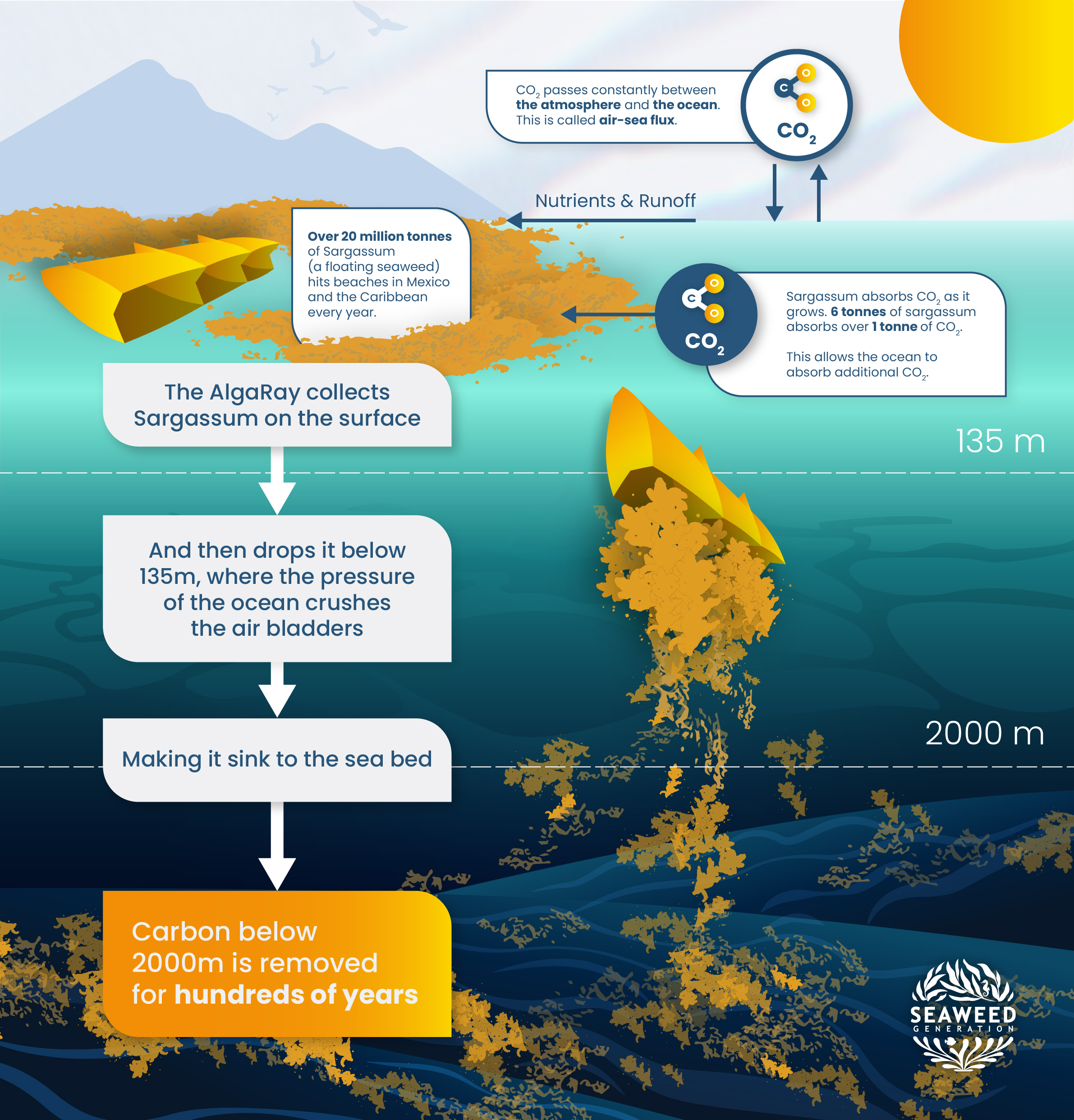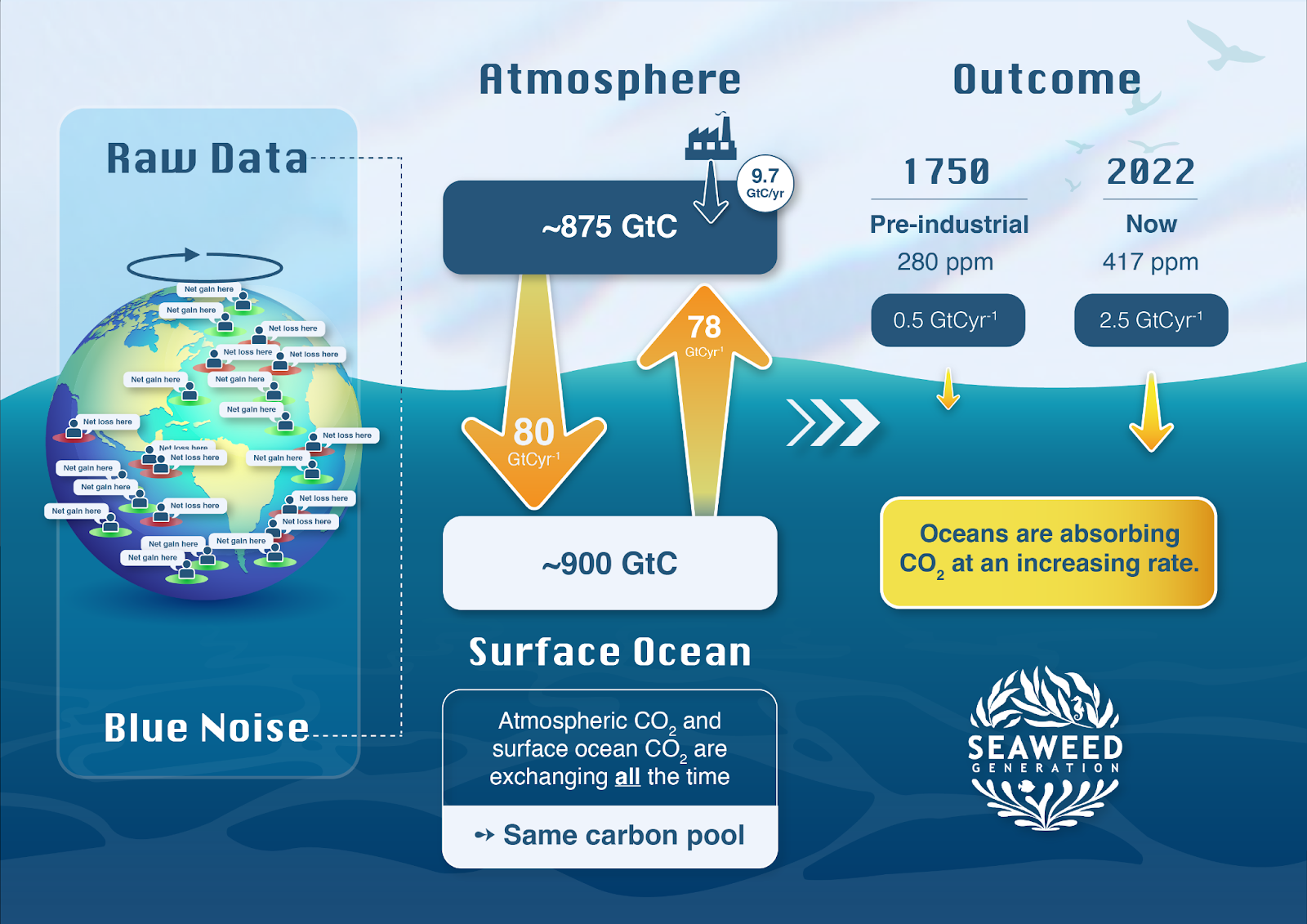Carbon Removal With Seaweed
How does sinking seaweed in the ocean remove Carbon Dioxide from the atmosphere?
Sargassum, like all seaweeds and plants, relies on the light of the sun to photosynthesise and grow. One of the elements it needs to do this is carbon which it obtains from CO2 in the surrounding water, the plant does not breathe air from the atmosphere. But the ocean and atmosphere are constantly jockeying for equilibrium and, by means of some complex chemistry and physics, as carbon dioxide is removed from surface waters, it is replenished from the atmosphere.

This is a really interesting topic for discussion, and one which we have found ourselves talking about with investors, colleagues, collaborators and anyone else who’ll listen to us. There are actually a few different ways you can go about answering this question, but all you really need is an understanding of how the global carbon cycle works to really get to grips with it. There’s a lot of great resources online to tell you more about it, this is one of our favourites and it helped us come up with diagrams below.
Seaweed is growing photosynthetically and sourcing its carbon dioxide from the ocean. Simple, right? Er, not quite! It’s a little bit more complex than that. As you know, Planet Earth is covered ~70% by water. This water is continually exchanging gases (including CO2) with the atmosphere1. On a massive scale. Take a look at the diagram below. There are about 875 gigatonnes of carbon (GtC) in the atmosphere (or petagrams if you prefer those units…).
There’s slightly more in the surface ocean waters: about 900 GtC. The CO2 in the surface waters is constantly moving into the atmosphere, and the CO2 in the atmosphere is constantly moving into the surface waters. The scale of this movement is absolutely massive: about 80 GtC per year. To put that into perspective, our industrial emissions of CO2 are about 4 GtC per year.
With that rate of exchange, removing CO2 from the surface ocean is just as good as removing it from the atmosphere. They are two sides of the same coin. Atmospheric or Surface Ocean… It’s all the same CO2 pool, the CO2 is moving freely in between the two. We actually think it’s better to remove it from the ocean. And here’s why.

At the local scale, when the surface of the ocean has more CO2 in it than the atmosphere, there will be a net movement of CO2 out of the sea. Like a fizzy drink going flat when you open the bottle or can. But, when the atmosphere has more CO2 than the water it’s in contact with, there will be a net movement into the ocean. Different parts of the world at different times will have a net losses or net gains of variable sizes, it’s very dynamic process with an almost infinite number of moving parts2. We are forever reading stories about the latest work proving seaweed X in location Y produces netflux Z under very precise conditions ABCDEFGHIJKLMNOP has a net gain or a net loss345678910. It’s pretty confusing to the layman. It’s all rather contentious and the debates get quite heated.
What you need to remember is this: overall, globally, the net direction of travel is CO2 goes INTO the oceans. That’s exactly the situation we’re making worse with our CO2 emissions.
The oceans have become the major sink for atmospheric carbon dioxide, indeed, they have been doing a very successful job of hiding/mitigating against the massive amounts we have been producing - absorbing a third of human emissions already11. Before the industrial revolution (at 280 ppm) the ocean was a sink for CO2 at around 0.5 GtC per year. Now it’s up to 2.5 GtC per year (as I write this on the 12th August 2022 it stands at 417 ppm).
Because of the lag in reaching an equilibrium (you’ve already seen the scales and complexity involved here), it doesn’t matter what we do about removing from the atmosphere via processes like direct air capture, the oceans will still be a net receiver of CO2 and will continue to absorb CO2. This is a terrible situation for oceanic life: ocean acidification in the surface oceans is causing massive problems. So, we must get it out of there.
The difference between ocean based and non-ocean based CDR is that removing it from the atmosphere won’t have much impact on the oceans. But removing it from the oceans will have an impact on both the atmospheric AND the oceanic CO2 levels.
The overall impact of removing the seaweed at the surface of the ocean to the bottom of the deep ocean is relatively simple to understand: the seaweed has utilised lots of CO2 in order to grow by photosynthesis, so by sinking it to the bottom of the ocean and removing it from the surface carbon cycle12, we are effectively reducing what’s known as the partial pressure (pCO2) of the water, which means more atmospheric CO2 will have to enter the oceans to balance it. So, we remove it from the oceans, and the atmospheric transfer responds. It’s very dynamic and of course there’s a time delay, nothing on a planetary scale is instantaneous, but our conservative modelling suggests most (>90%) of the CO2 will enter from the atmosphere to replace the oceanic CO2 we have removed and it will do this over a period of 8-9 months.
-
Global Carbon Budget 2019 (Earth System Science Data) ↩
-
Natural variability in air–sea gas transfer efficiency of CO2 (Scientific Reports) ↩
-
Reassessing Southern Ocean Air-Sea CO2 Flux Estimates With the Addition of Biogeochemical Float Observations (Global Biogeochemical Cycles) ↩
-
Decadal variability of the air-sea CO2 fluxes in the equatorial Pacific Ocean (Journal of Geophysical Research, Oceans) ↩
-
Ship-based measurement of air-sea CO2 exchange by eddy covariance (Journal of Geophysical Research, Atmospheres) ↩
-
Role of the Southern Annular Mode (SAM) in Southern Ocean CO2 uptake (Global Biogeochemical Cycles) ↩
-
An increasing CO2 sink in the Arctic Ocean due to sea-ice loss (Geophysical Research Letters) ↩
-
Air–sea CO2 fluxes in the Caribbean Sea from 2002–2004 (Journal of Marine Systems) ↩
-
Arctic Ocean CO2 uptake: an improved multiyear estimate of the air–sea CO2 flux incorporating chlorophyll a concentrations (Biogeosciences) ↩
-
Air-sea CO2 fluxes and the continental shelf pump of carbon in the Chukchi Sea adjacent to the Arctic Ocean (Journal of Geophysical Research, Oceans) ↩
-
Global ocean storage of anthropogenic carbon (Biogeosciences) ↩
-
Important contribution of macroalgae to oceanic carbon sequestration (Nature Geoscience) ↩